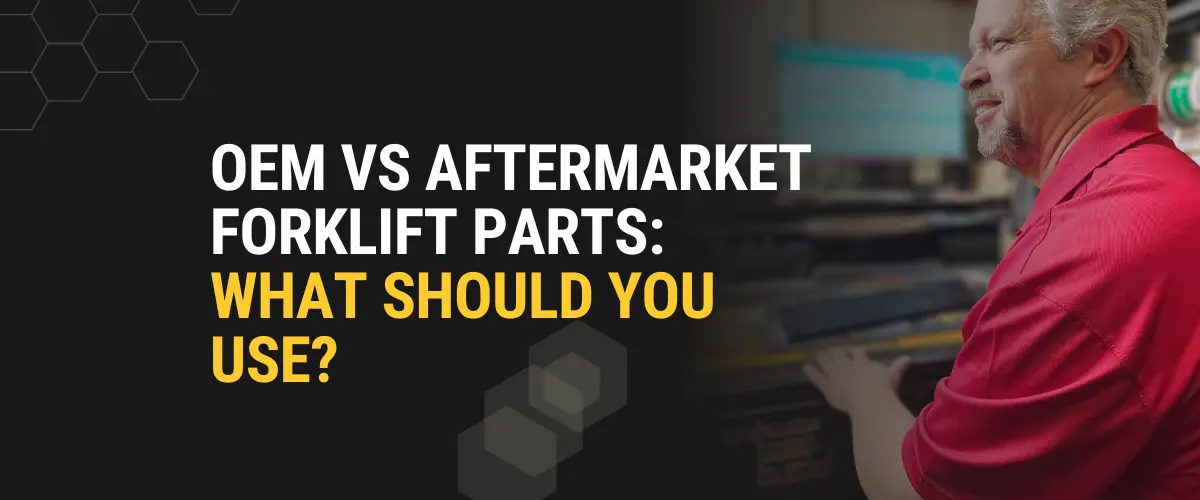
OEM vs Aftermarket Forklift Parts: What Should You Use?
If you run a fleet or manage maintenance, this probably sounds familiar. A part breaks, someone checks stock, and the next question is, “Do we go OEM or aftermarket?”
It’s a simple question, but the answer can get a little tricky.
Sometimes it’s just about what’s available. Other times, cost plays a big role. And if the machine’s still under warranty? That changes things too.
So here’s the breakdown. Just what you need to know when you’re trying to get a forklift back in service without making the wrong call on parts.
What “OEM” Actually Means
OEM stands for original equipment manufacturer. Basically, the part is made by the same company that built your forklift, or at least built the original version of that component.
So it fits the way it’s supposed to. Works how it’s supposed to. And it’s likely covered under your forklift’s factory warranty, if that still applies.
If your machine is newer, or if it’s doing mission-critical work, this is usually the safer call.
What About Aftermarket Parts?
These are made by someone else. A third-party brand. They’re designed to do the same job and fit the same spot, but they’re not built by the OEM.
That doesn’t automatically mean bad quality. Some are great. Others… not so much.
You can save money up front, especially on high-turnover parts like filters, tires, or forks. But depending on the brand, you might run into shorter lifespans or small fit issues that slow down the install.
When OEM Makes Sense
- The forklift’s still under warranty
- The part is tied to safety or emissions
- You can’t afford to risk poor fit or function
- You’ve had trouble with third-party stuff in the past
OEM parts are also a good idea if this repair is the kind you don’t want to do again anytime soon. Think hydraulic components, steering parts, or electrical systems.
When Aftermarket Might Be Fine
If the machine’s out of warranty and the job is routine, aftermarket parts can work just fine. Things like:
- Brake pads
- Air and oil filters
- Light bulbs
- Seat cushions
- Tires
Just make sure you’re buying from a trusted source. Some aftermarket brands cut corners. Others are excellent. You don’t want to find out the hard way.
Here’s the Catch
The difference in cost isn’t always huge. What really matters is time. If you can’t get an OEM part for three weeks but can get a reliable aftermarket version tomorrow, that’s worth thinking about.
Downtime costs more than a few extra dollars on a part. If you’re stuck waiting and the machine’s down, that’s where the real expense shows up.
Not Sure What to Choose?
At Thompson Lift Truck, we carry both OEM and aftermarket forklift parts. And we don’t push one or the other. We ask what kind of machine you’re running, what the part does, and how soon you need it.
Sometimes OEM is the right move. Other times, we’ve got a solid aftermarket option that saves you money and time.
Either way, we’ll help you figure it out.
FAQs: OEM vs Aftermarket Forklift Parts
What’s the difference between OEM and aftermarket forklift parts?
OEM parts come from the original forklift manufacturer. Aftermarket parts are made by third-party companies.
Are aftermarket forklift parts bad?
Not necessarily. Some are high quality. It depends on the brand and the part.
Do OEM forklift parts last longer?
Usually, yes. They’re built to factory spec. But there are solid aftermarket parts that hold up well too.
Can I use aftermarket parts on a forklift under warranty?
Probably not. That could void the warranty, especially on key systems.
Can Thompson Lift Truck help me choose the right part?
Yes. We’ll walk you through your options and help you choose what makes the most sense.

